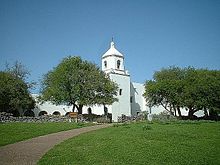- Mission Nuestra Señora del Espíritu Santo de Zúñiga
-
Mission Nuestra Señora del Espíritu Santo de Zúñiga 
The chapel facade of Mission Nuestra Señora del Espíritu Santo de Zúñiga.
Basic information Location Goliad, Texas
 USA
USAGeographic coordinates 28°39′15″N 97°23′07″W / 28.654253°N 97.385259°WCoordinates: 28°39′15″N 97°23′07″W / 28.654253°N 97.385259°W Affiliation Roman Catholic Architectural description Architectural style Spanish Completed Founded 1722 Specifications Materials stone and mortar U.S. National Register of Historic Places Added to NRHP: August 22, 1977 Mission Nuestra Señora del Espíritu Santo de Zúñiga also known as Aranama Mission or Mission La Bahia was a Roman Catholic mission established by Spain in Victoria County, Texas in northern New Spain in 1722 to convert local Native Karankawa Indians to Christianity. Together with its partner Presidio La Bahia, they would solidify Spanish territorial claims in the New World against encroachment from France. Today, the third and final structure, near Goliad, Texas is maintained as a Texas State Historical Park and museum.
Establishment
Established in 1722 on Matagorda Bay near La Salle's Fort Saint Louis on Garcitas Creek, the mission and complementing presidio (fort) was intended to secure the Texas coastline from the French and to gather the local Cocos, Copanes, and Cujanes. Being unable to attract the Indians to stay at the mission and due to violence with the Spanish soldiers, the mission was relocated only four years later, to a more favorable location on the Guadalupe River. Artifacts from this settlement are currently on display at the Museum of the Coastal Bend in Victoria.[1]
Moved in 1726 near Victoria, it was established among the Tamique and Aranama Indians in Mission Valley. Dams and stone acequias were built to carry water from the river to the mission. A ranching outpost was also built of mortar and stone at Tonkawa Bank, on the river about 12 miles below. The presidio also followed and was built at what was later to become Fernando De Leon's Ranch. The establishment prospered for 26 years, producing enough grain and hay to trade with other Spanish settlements. It was at this time that the foundation for cattle and horse ranching started. Although prosperous, Spanish officials recommended moving the mission to secure the area between Bexar and East Texas from the encroachment of the French and English.
Mission La Bahia moved in 1749 to La Bahia (now Goliad, Texas) on the San Antonio River. Temporary jacale housing for was built from log and clay, with construction of a stone and mortar complex being immediately initiated and reaching completion in 1758. The mission was built with surrounding stone walls and included rooms to house the priests and the Indian families, a granary, workrooms and a separately located forge. The complementing presidio was built just across the river and at times housed Texian troops during the Texas Revolution. The mission found success educating and serving the Aranama, Piguique, Manos de Perro, Tamique, Tawakoni, and Tonkawa in the area, but usually faced opposition from raiding Apaches and Commanches.[2]
The mission became the first large cattle ranch in Texas, with near 40,000 free roaming cattle at the height of production in about 1778. The large herds of longhorns and mustangs were cared for by the vaquero Indians from the mission. They also grew large crops of grain, fruit and vegetables to support the residents and trade with others. Cattle and livestock were also driven and traded with the other missions in Texas and Louisiana.
The mission was to be secularized in 1794, but La Bahia remained in service until Mexican Independence in 1821. However, two Franciscans refused to leave and remained as parish priests. In 1830 the mission was finally secularized. With most Indians having already left, the premium lands of the mission were acquired by the local Mexican and American colonists. The old mission's stones were also allowed to be removed and used for local construction.[3]
The remaining structure was used a public school in 1848–1856 and gradually fell into ruin.
The mission was restored from ruins by the Civilian Conservation Corps and Works Progress Administration in 1930 and became a State Park in 1931 and is currently operated by the State of Texas Parks and Wildlife Department. Additional construction in the 1960s and 1980s brought its appearance back to the 1749 mission.
It was added to the National Register of Historic Places in 1977.
References
- ^ Craig H. Roell, "LA BAHIA," Handbook of Texas Online (http://www.tshaonline.org/handbook/online/articles/uql01), accessed April 16, 2011. Published by the Texas State Historical Association.
- ^ Craig H. Roell and Robert S. Weddle, "NUESTRA SENORA DE LORETO DE LA BAHIA PRESIDIO," Handbook of Texas Online (http://www.tshaonline.org/handbook/online/articles/uqn11), accessed April 07, 2011. Published by the Texas State Historical Association.
- ^ Craig H. Roell, "NUESTRA SENORA DEL ESPIRITU SANTO DE ZUNIGA MISSION," Handbook of Texas Online (http://www.tshaonline.org/handbook/online/articles/uqn16), accessed April 16, 2011. Published by the Texas State Historical Association.
Early Texas Settlements Spanish Missions in Texas Mission San Francisco de la Espada · Mission San Juan Capistrano (Texas) · Mission Concepción · Alamo Mission in San Antonio · Mission San José (Texas) · Mission Nuestra Señora del Espíritu Santo de Zúñiga · Mission Santa Cruz de San SabáSpanish Forts of Texas Armed conflicts Empresarios See also Categories:- Spanish missions in Texas
- Religious buildings completed in 1722
- Religious buildings completed in 1758
- National Historic Landmarks in Texas
- Buildings of religious function on the National Register of Historic Places in Texas
- History museums in Texas
- Spanish Colonial architecture in Texas
- Buildings and structures in Victoria County, Texas
- Museums in Goliad County, Texas
Wikimedia Foundation. 2010.


